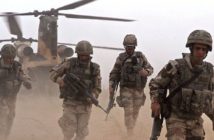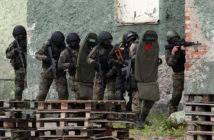Malta Independent Online
Scanning Africa’s map from north to south and east to west, there is hardly a state untouched by violence. In our immediate neighborhood, North Africa, unrest stretches from the frozen conflict in Western Sahara to the post-civil war violence in Libya, and the post-Arab spring instability in Tunisia and Egypt. Further away to the East is the Horn of Africa, with Somalia at the epicentre, where violence is endemic and is driving thousands to our shores in search of a better life. Throughout the conflict belt in sub-Saharan Africa especially Mali, the Central African Republic, Chad and Sudan armed conflicts have driven whole populations to a life of fear, disease and unremitting poverty.
In West Africa, brutal civil wars and military coups in Nigeria, Ivory Coast, Liberia, Sierra Leone, Guinea-Bissau, Ghana and Burkina Faso, have left thousands butchered and maimed. The Great Lakes region in East Africa has similarly been the site of extreme violence with an on-going armed conflict in the Democratic Republic of Congo, volatile ethnic situations in Rwanda and Burundi, and the ravaging terror of Joseph Kony’s Lord’s Resistance Army originating from Uganda. Further south, Angola and Mozambique have similarly gone through a process of lengthy civil wars, Zimbabwe remains in the grips of a pariah dictator, while in South Africa the blight of Apartheid is only slowly disappearing.
Armed conflicts in Africa are mostly intrastate conflicts resulting from the weakness of governing institutions in the countries involved, ethnic and sectarian hatreds, competition for land and natural resources, demographic shifts, and the uncontrolled ambition and greed of political and military leaders. They include many actors – governments, armed political and separatist militias, rebel movements, tribal clans, ethnic and religious groups, expatriate terrorist groups, child soldiers, mercenaries and criminal gangs. The victims are generally the weakest and most vulnerable sections of the population – women, children and the poor. It is estimated that 75 per cent of the poorest people in the world have recently been through a civil war or are going through one.
Rudimentary weapons such as machetes, agricultural implements, and makeshift armaments are frequently used especially in the initial stages of violence and in spontaneous uprisings. However, small arms and light weapons are responsible for most of the killing, and most of the armed conflicts in Africa have been fought, or are being fought, almost exclusively with such weapons. Despite its poverty, Africa has been the market for many arms purchases in recent years. It is significant that after the Cold War, while arms transfers from industrial to developing countries have declined, imports of small arms and light weapons have been on the rise in sub-Saharan Africa.
The Small Arms Survey, citing the UN Panel of Governmental Experts, defines “small arms” as revolvers and self-loading pistols, rifles and carbines, assault rifles, sub-machine guns and light machine guns. It lists the following as “light weapons”: heavy machine guns, hand-held and mounted grenade launchers, portable anti-tank and anti-aircraft guns, recoilless rifles, portable launchers of anti-tank and anti-aircraft missile systems, and mortars of less than 100mm calibre. Portability is the defining characteristic. This makes them the preferred armaments of rebel groups and armed militias, whose method of fighting, kill and burn, rape and pillage, demands flexibility and rapid movement. The ubiquitous weapon is the Kalashnikov, which is easy to replicate and produce in bulk, not difficult to use, and is cheap and effective.
The Small Arms Survey 2013 estimates that there are some 875 million small arms and light weapons in circulation worldwide. Between 530,000 and 580,000 are produced annually, either under licence or as unlicensed copies, by an estimated 1,249 companies in more than 90 countries, making supply-end restrictions difficult. The international small arms trade is worth 8.5 billion US$, with a further 2 billion US$ spent on illegal trade. The largest exporters are Russia, the United States, China, Brazil, Italy, Germany, France, Belgium and the United Kingdom. The most transparent exporters are the Unites States and Germany, while the least transparent are Bulgaria, Iran, Israel and North Korea.
The black market for small arms and light weapons is mostly sustained by leaks from stockpiles of unused weapons. Wealthy states will continue to upgrade their arsenals and plan the procurement of more sophisticated weapons, creating a cascade of surplus weapons. Unless states undertaking substantial weapons upgrading programmes systematically destroy surplus stocks, there will inevitably be large transfers to secondary markets. According to the Small Arms Survey 2013 the global rise in arms procurement could mean a market for surplus small arms of about 280,000 units a year.
Very often the distinction between legal trade, carried out under government control and in accordance with both national law and international law, and the illegal trade is hazy. It is not unusual for governments and their agents either to go around national and international regulations or to exploit loopholes in the rules to allow weapons to reach non-state actors. Their aim is to arm rebel group with similar ideological agendas who are involved in insurgencies against rival governments. Many Cold War networks for arms trafficking survive. Such transfers are often conducted in contravention to United Nations embargoes or without adequate end-user assurances.
The diversion from legal to illegal channels is mostly responsible for the trafficking of the small arms and light weapons that are sustaining armed conflicts in Africa. Through corruption and wilful neglect millions of weapons are allowed to reach Africa’s conflict regions. Experienced arms brokers resort to what is known as “ant trade” involving numerous shipments of small numbers of weapons that over time accumulate to large quantities in the hands of unauthorised users. Multi-ton, inter-continental shipments by the so called “merchants of death” in fact account to only a small fraction of illegal arms transfers.
Africa’s rich natural resources attract illegal arms dealers. Most of the armed conflicts in Africa have been funded by the plundering of its valuable resources – diamonds, gold, timber, oil, minerals, cocoa and coffee. These commodities have helped pay for the estimated 12 – 15 million small arms and light weapons believed to be circulating in Africa’s conflict regions.
Not much has been achieved by national governments and the international community in dealing decisively with the small arms transfers that are making today’s armed conflicts in Africa possible. Efforts to control the proliferation of small arms and light weapons started in the mid-1990s, following the terrible conflicts and genocides in the Great Lakes region of East Africa. The key actor at the international level has been the United Nations. In 1996 the UN Secretary General created a UN panel of government experts on small arms. This led to the 2001 UN Conference on the Illicit Trade in Small Arms and Light Weapons. The objective was to reach an international agreement on a programme of action which will commit states to implement agreed measures for the prevention and control of black market arms transfers and brokering. The resulting programme of action was very weak, merely setting minimum global standards and practices related to small arms proliferation, without being legally binding. A review conference held in 2006 was a dismal failure, unable even to produce an outcome document. A second review conference in 2012 managed to agree on an outcome document in which the participating states committed themselves to implement fully the 2001 programme of action by 2018. And that is all.
There is evidence showing that armed conflicts in Africa, mostly intrastate conflicts, can be significantly reduced simply by preventing small arms and light weapons from reaching combatants, both governments and insurgents/rebel groups. Unfortunately, there is not much optimism that the control mechanisms, modest as they are, established by the international community will work. There is perhaps a cynical reason for this: the most influential states in the international system, that is those with the power to bring about change in the global governance of armaments, are the same states that have the largest defence sector and that benefit most from global arms sales. Poor Africa!







